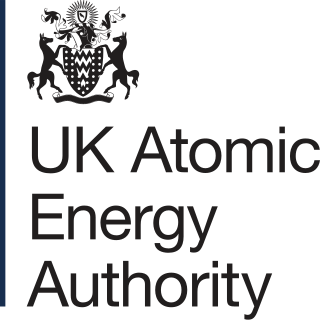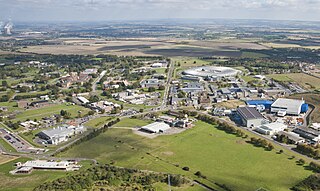Related Research Articles

The Atomic Energy Research Establishment (AERE) was the main centre for atomic energy research and development in the United Kingdom from 1946 to the 1990s. It was created, owned and funded by the British Government.

Sir John Douglas Cockcroft was a British physicist who shared with Ernest Walton the Nobel Prize in Physics in 1951 for splitting the atomic nucleus, and was instrumental in the development of nuclear power.

The United Kingdom Atomic Energy Authority is a UK government research organisation responsible for the development of fusion energy. It is an executive non-departmental public body of the Department for Energy Security and Net Zero (DESNZ).

The United States Department of Energy National Laboratories and Technology Centers is a system of laboratories overseen by the United States Department of Energy (DOE) for scientific and technological research. The primary mission of the DOE national laboratories is to conduct research and development (R&D) addressing national priorities: energy and climate, the environment, national security, and health. Sixteen of the seventeen DOE national laboratories are federally funded research and development centers administered, managed, operated and staffed by private-sector organizations under management and operating (M&O) contracts with the DOE.

The Rutherford Appleton Laboratory (RAL) is one of the national scientific research laboratories in the UK operated by the Science and Technology Facilities Council (STFC). It began as the Rutherford High Energy Laboratory, merged with the Atlas Computer Laboratory in 1975 to create the Rutherford Lab; then in 1979 with the Appleton Laboratory to form the current laboratory.

Pakistan Atomic Energy Commission (PAEC) is a federally funded independent governmental agency, concerned with research and development of nuclear power, promotion of nuclear science, energy conservation and the peaceful usage of nuclear technology.

Sir Ernest William Titterton was a British nuclear physicist.

Daresbury Laboratory is a scientific research laboratory based at Sci-Tech Daresbury campus near Daresbury in Halton, Cheshire, England. The laboratory began operations in 1962 and was officially opened on 16 June 1967 as the Daresbury Nuclear Physics Laboratory by the then Prime Minister of United Kingdom, Harold Wilson. It was the second national laboratory established by the British National Institute for Research in Nuclear Science, following the Rutherford High Energy Laboratory. It is operated by the Science and Technology Facilities Council, part of UK Research and Innovation. As of 2018, it employs around 300 staff, with Paul Vernon appointed as director in November 2020, taking over from Professor Susan Smith who had been director from 2012.
The Science and Technology Facilities Council (STFC) is a United Kingdom government agency that carries out research in science and engineering, and funds UK research in areas including particle physics, nuclear physics, space science and astronomy.

The Harwell Science and Innovation Campus is a 700-acre science and technology campus in Oxfordshire, England. Over 6,000 people work there in over 240 public and private sector organisations, working across sectors including Space, Clean Energy, Life Sciences and Quantum Computing.
Sir Alexander Walter Merrison FRS was a British physicist. He was a professor in Experimental Physics at Liverpool University and the first Director of the new Daresbury Nuclear Physics Laboratory. He later became Vice-Chancellor of University of Bristol.
John David Lawson FRS was a British engineer and physicist.

A neutron research facility is most commonly a big laboratory operating a large-scale neutron source that provides thermal neutrons to a suite of research instruments. The neutron source usually is a research reactor or a spallation source. In some cases, a smaller facility will provide high energy neutrons using existing neutron generator technologies.
NINA (Northern Institute's Nuclear Accelerator) was a particle accelerator located at Daresbury Laboratory, UK that was used for particle physics and as a source of synchrotron radiation.
Peter Ignaz Paul Kalmus, is a British particle physicist, and emeritus professor of physics at Queen Mary, University of London.
Albert Edward "Ted" Litherland is a nuclear physicist, known for his pioneering work in accelerator mass spectroscopy (AMS).

Sir Steven Charles Cowley is a British theoretical physicist and international authority on nuclear fusion and astrophysical plasmas. He has served as director of the United States Department of Energy (DOE) Princeton Plasma Physics Laboratory (PPPL) since 1 July 2018. Previously he served as president of Corpus Christi College, Oxford, since October 2016. and head of the EURATOM / CCFE Fusion Association and chief executive officer of the United Kingdom Atomic Energy Authority (UKAEA).
Dilip Devidas Bhawalkar is an Indian optical physicist and the founder director of the Raja Ramanna Centre for Advanced Technology (CAT), an institute under the Department of Atomic Energy, serving as a centre for higher studies in the fields of lasers and particle accelerators. He is credited with pioneering research in optics and lasers in India and is reported to have contributed in making CAT a partner in the International Linear Collider and Large Hadron Collider experiments of the European Organization for Nuclear Research (CERN). He is a recipient of the Shanti Swarup Bhatnagar Prize, the highest Indian award in science and technology. The Government of India awarded him the fourth highest civilian award of the Padma Shri in 2000.

The Atomic Energy Authority Act 1959 is an Act of the Parliament of the United Kingdom which amended and extended the constitution and powers of the United Kingdom Atomic Energy Authority.
References
- 1 2 "National Institute for Research in Nuclear Science" (PDF). Nature. 179 (4556): 400. 23 February 1957. doi:10.1038/179400a0. S2CID 4219736 – via nature.com.
- 1 2 3 "Records of the National Institute for Research in Nuclear Science". discovery.nationalarchives.gov.uk. Retrieved 26 October 2021.
- ↑ "Privy Council Record of Royal Charters". privycouncil.independent.gov.uk. Retrieved 26 October 2021.
- ↑ Hansard Commons vol 566 12 March 1957 National Institute for Research in Nuclear Science (Governing Body)
- ↑ "The Rutherford High Energy Laboratory of the National Institute for Research in Nuclear Science". Contemporary Physics. 3 (2): 145–49. 1961. doi:10.1080/00107516108223216.
- ↑ "The Rutherford High Energy Laboratory of the National Institute for Research in Nuclear Science". Contemporary Physics. 3 (2): 145–149. 1961. doi:10.1080/00107516108223216 . Retrieved 26 October 2021.
- ↑ "Nuclear task for National Institute". The Times. 19 April 1961. p. 6.
- ↑ "Details of Atomic Research effort". The Times. 12 July 1961. p. 7.
- ↑ "Daresbury Laboratory" . Retrieved 27 October 2021.
- ↑ "Institutes to house costly scientific equipment". The Times. 5 January 1962. p. 5.
- ↑ "Three new Research Agencies proposed". The Times. 31 October 1963. p. 12.